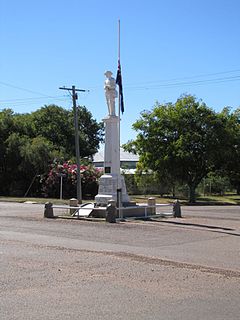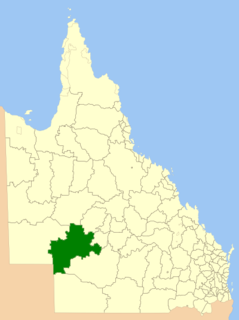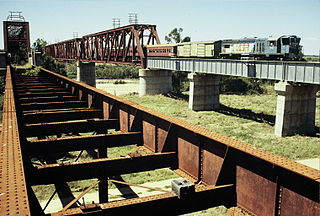
Winton is a town and locality in the Shire of Winton in Central West Queensland, Australia. It is 177 kilometres (110 mi) northwest of Longreach. The main industries of the area are sheep and cattle raising. The town was named in 1876 by postmaster Robert Allen, after his place of birth, Winton, Dorset. Winton was the first home of the airline Qantas.

Aramac is a rural town and locality in the Barcaldine Region, Queensland, Australia. In the 2016 census, Aramac had a population of 299 people.
Flight West Airlines was an Australian regional airline headquartered in Brisbane, Queensland. Established in May 1987, it operated predominantly in Queensland. The airline went into voluntary liquidation on 19 June 2001 before being sold to Queensland Aviation Holdings, the parent company of Alliance Airlines in April 2002. The company slogan is Jetting into new territory.

Yaraka is a rural town and locality in the Longreach Region of Queensland, Australia. Until 2021, the town of Yaraka was part of the locality of Isisford.

The Shire of Aramac was a local government area located in central Queensland about 1,100 kilometres (684 mi) north west of the state capital, Brisbane, between the towns of Barcaldine and Winton. It covered an area of 23,364.1 square kilometres (9,020.9 sq mi), and existed as a local government entity from 1879 until 2008, when it amalgamated with the Shires of Barcaldine and Jericho to form the Barcaldine Region.

The Diocese of Rockhampton is a diocese of the Anglican Church of Australia, founded in 1892. It is situated in the central part of the state of Queensland, Australia. It is part of the Province of Queensland. The cathedral church of the diocese is St Paul's Cathedral in Rockhampton.

The Shire of Barcoo is a local government area in Central West Queensland, Australia. In June 2018, the shire had a population of 267 people.

The Roman Catholic Diocese of Rockhampton is a suffragan Latin Church diocese of the Archdiocese of Brisbane, erected in 1882, covering Central Queensland, Australia.

The Barcaldine Region is a local government area in Central West Queensland, Australia. Established in 2008, it was preceded by three previous local government areas which had existed for over a century.

Queensland's railway construction commenced in 1864, with the turning of the first sod of the Main Line by Lady Diamantina Bowen, the wife of Queensland's first governor Sir George Bowen at Ipswich, Queensland, Australia. A narrow gauge of 3 ft 6 in was selected due to cost savings in providing a rail link to Toowoomba. Despite being built with bridges wide enough for standard gauge, and the fact that most other lines did not require heavy earthworks, the gauge remained the Queensland system norm.

The Great Northern Railway is a 1,067 mm railway line in Queensland, Australia. The line stretches nearly 1,000 kilometres linking the port city of Townsville, Australia to the mining town of Mount Isa in north-west Queensland. Along with a passenger service called the Inlander, it is a major freight route connecting the Mount Isa Mines to the Port of Townsville. In 2010 the line moved 5.8 million tonnes of cargo, and this is expected to increase significantly in coming years.

Central West Queensland is a remote region in the Australian state of Queensland which covers 396 650.2 km2. The region lies to the north of South West Queensland and south of the Gulf Country. It has a population of approximately 12,387 people.

The Hughenden-Winton railway line was a railway line in Queensland, Australia, branching from the Mt Isa line at Hughenden and connecting to the Central West line at Winton.

The Western railway line is a narrow gauge railway, connecting the south-east and south-west regions of Queensland, Australia. It commences at Toowoomba, at the end of the Main Line railway from Brisbane, and extends west 810 km to Cunnamulla, passing through the major towns of Dalby, Roma and Charleville, although services on the 184 km section from Westgate to Cunnamulla have been suspended since 2011. The Queensland Government was the first railway operator in the world to adopt narrow gauge for a main line, and this remains the system-wide gauge.

The Central Western railway line is a railway line in Queensland, Australia. It was opened in a series of sections between 1867 and 1928. It commences at Rockhampton and extends west 863 kilometres (536 mi) to Winton.
The Great Western Railway was a railway development proposal involving a total of five new lines in western Queensland, Australia. Construction started in 1911 on sections of four of the lines, and three were opened in part before the project was effectively abandoned in 1920.

A Travelling Post Office (TPO) is a postal receiving, sorting and delivery service situated on a train, usually in a specially designated carriage that is part of a passenger train. In Queensland, Australia, the service was provided from 1877 to 1932.

Longreach railway station is the terminus station of the Central Western line, serving the town of Longreach, Longreach Region, Queensland, Australia. It is on the Capricorn Highway. It was built from 1887 to 1917. It was added to the Queensland Heritage Register on 12 December 2005.
The Matilda Way is an Australian road route from Bourke, New South Wales to Karumba in Queensland. It has been designated by the Queensland Government as a State Strategic Touring Route.
Mexico is a former rural locality in the Barcaldine Region, Queensland, Australia. In the 2016 census, Mexico had a population of 26 people.
















